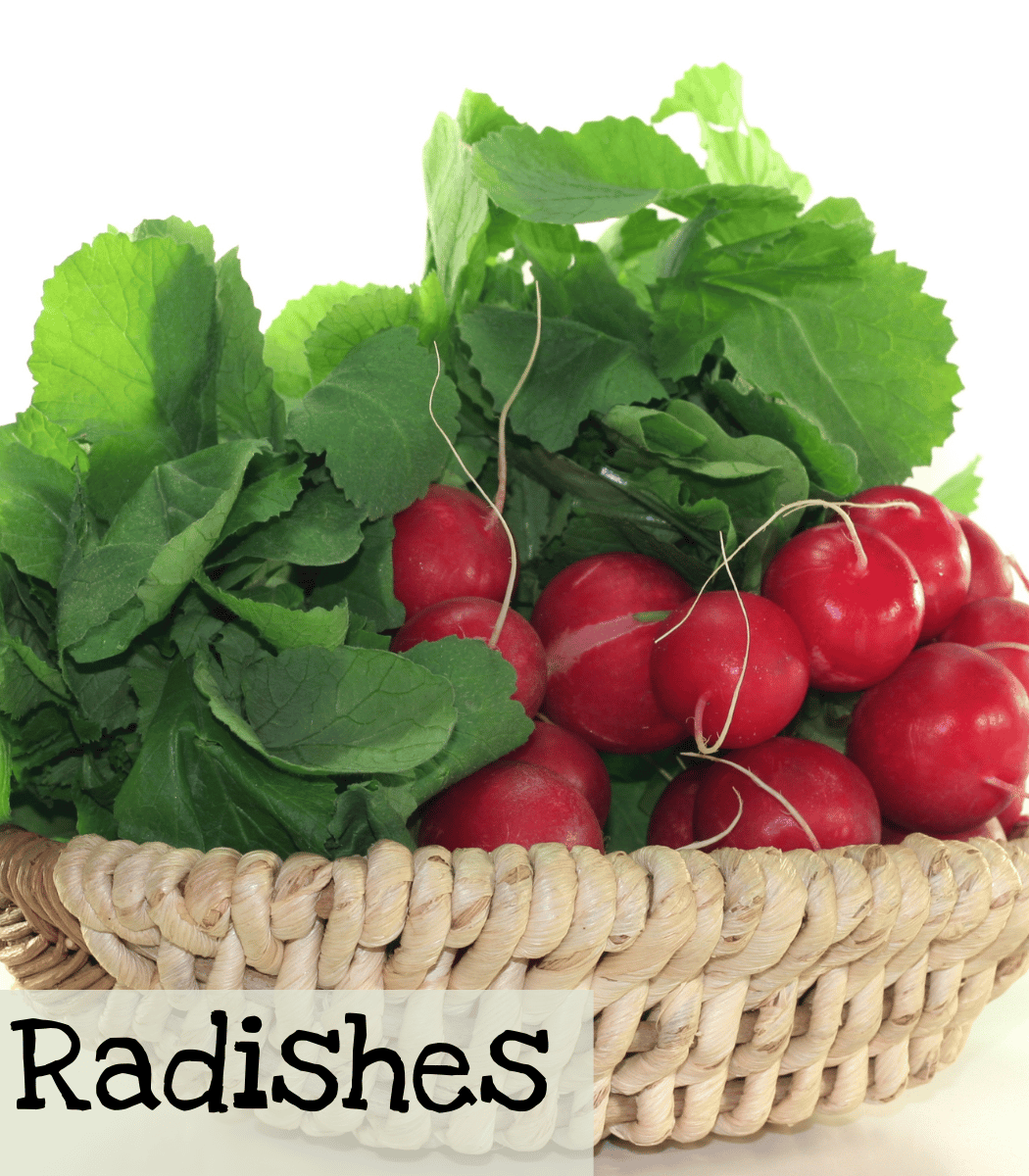
Radish
Radishes come in a wide range of colors. Deep purples, pinks and the common white add a riot of color and can spice up any salad or can be roasted. They are a cool-weather crop that can be grown in both the spring and fall.
|
Winter Radish: Black Spanish Round (***Checks out only in September***) Cherry Belle; China Jade; German Giant; Jantar; Royal Purple |
|
Raphanus sativus |
| Can be used as a trap crop | |
|
Intermediate to Easy |
|
Intermediate |
|
4-5 years if properly stored |
|
Annual |
|
4-10 days |
|
None |
|
1/2 inch |
|
4-6” x 4-6” |
|
Full sun |
|
20-29 days Black Spanish Round: 55 days |
|
Black Spanish Round: 3-5” Cherry Belle; Cherry Giant; Sparkler: 1” China Jade: 6-8” German Giant: 4” Royal Purple: 2” |
|
February, March, and September Black Spanish Round-only in September |
|
Yes |

Growing Tips



When to Start
Spring: Direct sow 4-6 weeks before the last frost and when temperatures reach 50° F. (Jan 15 – April 1 for GA)
Fall: Direct sow 6-8 weeks before the first frost. (Sep 1-Oct 15 for GA)
Using for pest management: Start soon enough so that the plant is mature at the time the pests you are trying to contain arrive.
How to Start
Prepare your garden soil by removing rocks and sticks. Break up the soil so it is loose and fine. Unless you do this, you won’t get any of your radishes to grow to any decent size. Direct sow ½ inch deep and 1 inch apart in full sun beds. Plants will germinate 4-10 days after planting. Stagger plantings by 8-10 days for a steady supply. Thin to 4-6 inches. Young leaves can be eaten.
Care
While radish is a cool-weather crop, row covers are helpful to protect the radishes from freezes. They like rich well-draining soil. Keep the soil moist but not soggy. Inconsistent water will cause the roots to split. Radishes don’t do well in the heat of summer and will often get woody and bolt.
Harvest
Radishes are ready for harvest when the plant leaves are about four inches long. You can start harvesting them right away at this point because the radishes are best when young and tender.
Pest Management
Snails and slugs like to eat the leaves of radishes. Cutworms and aphids can also be an issue. There are a few things that can be done to keep them under control. Try row covers. A fine mesh insect barrier cover is a good way to keep pests out. Also make use of companion planting to attract beneficial predators to eat the pests, and slug traps. Making an eggshell barrier also helps keep snails and slugs under control.
Radish MAY repel squash bugs. There’s not been a lot of scientific research done on this but, garden lore indicates this is a good thing to try. Using radishes in this way won’t hurt anything and may indeed help. Just keep in mind when using radishes this way, their purpose isn’t for eating. Squashes are warm-season crops and the radish will get woody and bolt, which is what you want for repelling purposes. Also, plant the radish close enough to the squash that it is touching the plants. This should give the best chance for repelling the squash bugs.
My personal experience
I tried using radishes as a pest repellant by growing them next to my summer squashes. I sowed radish next to my squashes at the same time I sowed the zucchini. They were planted close enough together so the radish would touch the zucchini. When using a plant as a repellent, you need the 2 plants to touch so the oils from the repellent plant will get onto the plant you are trying to protect.
For most of the growing season, I had no problems with squash bugs. I only had to remove the eggs of squash bugs a total of 2 times the whole summer. It is my belief the radish was responsible for the GREATLY reduced number of squash bugs. However, the radish didn’t seem to do anything for the squash vine borer.
Since this radish wasn’t for eating, I also got to try my hand at saving radish seed. I had no idea radish plants could get that large when they flower as I’ve always harvested them for eating prior to this. See Garden Experiments 2020 for more details!
Seed Saving

Isolation Distance
Radish will cross with other radish. Cage or bag blossoms to prevent cross-pollination or plant a half a mile apart.
Instructions
Seeds will mature after edible maturity. Dry pods on plants or harvest prior to frost. Allow pods to dry fully. Seeds and finer chaff are easy to separate by a variety of methods.
One way is to use two screens of varying mesh, one a little smaller than the seeds and the other a little larger. The first screen lets anything smaller than the seeds fall through, and the second lets the seeds through and stops anything larger.
Features
- Black Spanish Round: Heirloom, winter radish. Deep almost black skin with white flesh. Fairly hot, good raw or cooked. The root is a 3-5 inch turnip-shaped bulb. Plant in late summer and harvest when the weather starts to get cool. DO NOT plant in spring.
- Cherry Belle: Heirloom. Brightly flavored and crunchy. Good to eat raw and sliced into salads.
- China Jade: It’s a long radish with the most glossy, smooth leaves and white, cylindrical roots that reach 6-8 inches. It is very similar to The White Icicle radish and ideal for fresh eating. It is good in a stir fry, soup, or salad.
- German Giant: Large, globe-shaped radishes, 1 1/2″ across with crimson skin and mild white flesh. Firm, crisp, mild flavor. Attains a large size without becoming hollow to pithy.
- Jantar: This variety is a long, golden-skinned variety that originated in Poland. It’s spicy, pungent, and quick maturing.
- Royal Purple: It has a mildly sweet taste and firm flesh. Resistant to pests and disease.

Use up older seeds for protecting squashes. If the seeds don’t germinate, you haven’t lost anything, and since these radishes aren’t for eating it’s a great way to be thrifty by not spending money on new seeds.
You May Also Like:
Slug Traps-Eggshell barriers
Companion Planting: How to use flowers to help control pests.
Trap cropping: How to keep pests out of your main crop.
Sources:
Starting and Saving Seeds by Julie Thompson-Adolf
